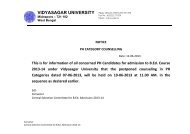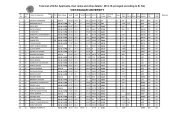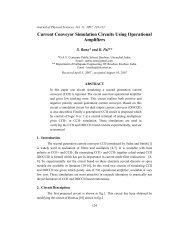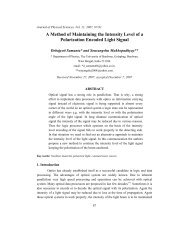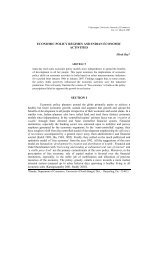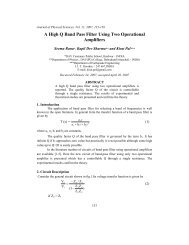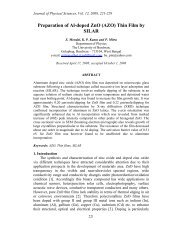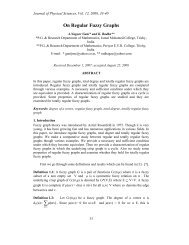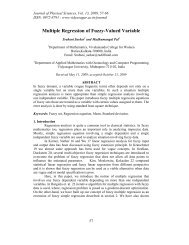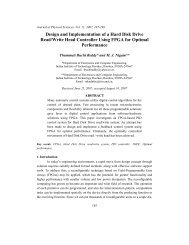VIDYASAGAR UNIVERSITY JOURNAL OF COMMERCE
VIDYASAGAR UNIVERSITY JOURNAL OF COMMERCE
VIDYASAGAR UNIVERSITY JOURNAL OF COMMERCE
Create successful ePaper yourself
Turn your PDF publications into a flip-book with our unique Google optimized e-Paper software.
Samirendra Nath Dhar, Kiranjit Sett, Soumitra Sarkar<br />
Kulshrestha (2000) identified that in spite of administration of many poverty alleviation<br />
programmes lack of capital was a serious constraint to development of women microentrepreneurs<br />
in rural areas. Kaladhar (1997) revealed that though micro enterprises<br />
generally have very small start up capital and they cannot provide collateral for loan and<br />
therefore micro-entrepreneurs depend on their friends / relatives or moneylenders for their<br />
credit needs. The moneylenders have traditionally provided credit to the rural poor, usually<br />
at excessively high rate of interest leading to considerable destitution and impoverishment of<br />
borrowers, including undesirable and illegal practices like bonded labour. The financial<br />
institutions did not have an adequate credit system for micro businesses, in place (both for<br />
saving and lending). However, the difficult procedures and requirements withheld the micro<br />
businesses from approaching traditional financial institution. Saving opportunities in FIs<br />
were very limited and it was seen that in many part of the country, saving with the<br />
moneylenders was prevalent.<br />
This situation, being prevalent worldwide, warranted establishment of alternative sources of<br />
finance for sustainable development of micro enterprises and fuelled the emergence of<br />
microfinance programmes in over a hundred countries. “ In India group based programmes<br />
have engaged first and foremost as a mechanism to allow the poor access to financial<br />
services that they have historically been denied” (Sen, 2003). Such programmes have been<br />
administered for the last two decades in a variety of forms and have multiplied rapidly. The<br />
SHG approach of lending was introduced to banks as a new micro finance approach with<br />
innovativeness and flexibility. Presently, the SHG-based microfinance is the main form of<br />
microfinance in India and it is well integrated into the formal banking system in India. The<br />
group based microfinance schemes have been introduced by the banks to cater cost effective<br />
finance to micro-entrepreneurs, the bulk of whom are women living below the poverty lines.<br />
Banking for Self Help Groups or SHG- Banking has developed into a new segment of<br />
banking for commercial banks, regional rural banks and cooperative banks.<br />
SHG- Banking – Features, Objectives and Advantages<br />
Large-scale outreach of microfinance services to the poor in India have been made possible<br />
through SHGs and the existing decentralised formal banking network including several<br />
organisations in the formal and non-formal sectors through SHG-Banking. These banking<br />
services are made accessible to the poor, especially women at minimal costs and are flexible<br />
enough to meet their needs. SHG-Banking has been designed and is being operated as an<br />
annexe cubicle of well established traditional banking practices. Traditional banking<br />
mandates written contracts with individuals, a clear amorphous project and activity for loan<br />
use, compulsory legal identification of the borrower, provision of collateral, etc. whereas in<br />
SHG Banking, the most rigid requirements of the formal banking system have been<br />
overthrown; SHG-Banking is need based and multiple credit injection system with ‘bankers<br />
to the poor’ approach. SHG Banking is a novel approach in banking where the effectiveness<br />
of microfinance activities lies in the extent of outreach to the poor and creating a sustainable<br />
means of livelihood for them. The focus of SHG banking is to operate in the low income<br />
client market segment which was considered as un-bankable so far. It operates with a vibrant<br />
Vidyasagar University Journal of Commerce 55



